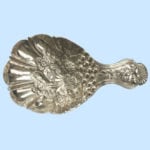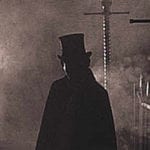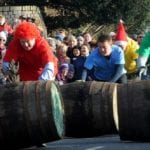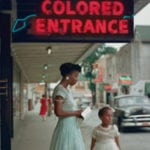 Miscellaneous
Miscellaneous  Miscellaneous
Miscellaneous  Our World
Our World 10 Green Practices That Actually Make a Difference
 Humans
Humans Ten Historic Men Who Deserve Way More Credit Than They Got
 Movies and TV
Movies and TV The 10 Most Heartwarming Moments in Pixar Films
 Travel
Travel Top 10 Religious Architectural Marvels
 Creepy
Creepy 10 Haunted Places in Alabama
 History
History Top 10 Tragic Facts about England’s 9 Days Queen
 Food
Food 10 Weird Foods Inspired by Your Favorite Movies
 Religion
Religion 10 Mind-Blowing Claims and Messages Hidden in the Bible Code
 Facts
Facts 10 Things You Never Knew about the History of Gambling
 Miscellaneous
Miscellaneous Ten Groundbreaking Tattoos with Fascinating Backstories
 Our World
Our World 10 Green Practices That Actually Make a Difference
 Humans
Humans Ten Historic Men Who Deserve Way More Credit Than They Got
Who's Behind Listverse?

Jamie Frater
Head Editor
Jamie founded Listverse due to an insatiable desire to share fascinating, obscure, and bizarre facts. He has been a guest speaker on numerous national radio and television stations and is a five time published author.
More About Us Movies and TV
Movies and TV The 10 Most Heartwarming Moments in Pixar Films
 Travel
Travel Top 10 Religious Architectural Marvels
 Creepy
Creepy 10 Haunted Places in Alabama
 History
History Top 10 Tragic Facts about England’s 9 Days Queen
 Food
Food 10 Weird Foods Inspired by Your Favorite Movies
 Religion
Religion 10 Mind-Blowing Claims and Messages Hidden in the Bible Code
 Facts
Facts 10 Things You Never Knew about the History of Gambling
10 Strange Christmas Traditions From The Victorian Era
Today, many of us associate December with traditions and festivities that seem like an integral part of Christmas. However, this wasn’t always the case. In fact, before the Victorian era, Christmas was only ever really minimally celebrated in Britain and in other English-speaking countries. It wasn’t until the reign of Queen Victoria and her German husband, King Albert, that Christmas became the truly festive celebration we recognize today. Thus, it is thanks to the Victorian era that most of our beloved Christmas traditions, such as Christmas cards, gifts, and Boxing Day, are popular.
However, the Victorian era was also responsible for a few slightly odder traditions. Most of them, unfortunately (or in some cases fortunately), did not survive into today. To remember the most interesting of those that did not make the cut, we have compiled a list of the most unusual Christmas customs of yesteryear that are sure to put you in a festive spirit.
10Creepy Christmas Cards

The Victorian era is responsible for the creation of the very first Christmas card, which was designed by John Callcott Horsley, an English painter, on the request of his wealthy friend, Sir Henry Cole. Cole initially came up with the idea for a Christmas card after he realized that he was much too busy to write an individual Christmas greeting to every person among his family, friends, and colleagues. Cole was sure that a card with a festive image and a greeting would be a far quicker way to send his holiday wishes to everyone.
After its initial success among Cole’s friends, 1,000 of these new Christmas cards were printed and put for sale in 1843. However, the Christmas card was not successful at first and was even disapproved by the temperance movement, which feared that the presence of booze in several of the original card designs would encourage drunkenness.
Nevertheless, a year later, Christmas cards became wildly popular, and soon their design varied enormously thanks to the various painters that had different visions for the ideal Christmas card. Like Victorian valentines, some of these new Christmas card designs featured cherubs, flowers, and other symbols of spring and new life. Others, however, were far creepier and included strange images such as sinister clowns poking policemen with red pokers, giant killer wasps chasing children, and gambling monkeys.
9Glass Pickle

A glass pickle ornament was often hidden inside the Victorian Christmas tree for good luck. On Christmas day, the founder of the glass pickle was either given a special gift or allowed to open their present first.
It is said that the tradition of the glass pickle originated from a medieval story of two Spanish boys traveling home for Christmas. On their way home, tired and weary from traveling, the children stopped at an inn for a good night’s sleep. However, the innkeeper was an evil man—he stole the boys’ possessions and stuffed them into a pickle barrel. Luckily for the boys, St. Nicholas stopped by the inn and saved them. The boys then thanked St. Nicholas for saving their lives and continued on to their family.
There exists a second version of the story, which differs slightly from the first. In this version, three Spanish boys are kidnapped by an evil shopkeeper who chops them up with an axe and pickles them in a barrel. Upon hearing about the poor boys’ faith, St. Nicholas prays to God, and because of the purity of his faith, he succeeds in restoring the lives and bodies of the boys.
8Wassail Punch

Wassail punch was a popular winter drink made from a mixture of fruit, cider, and spices. Victorians served it to carolers who went from house to house wassailing or singing Christmas carols and hymns. After all the carols were sung, the carolers were invited to the houses of Victorian families to share a sip of wassail from the communal wassail bowl. This tradition of inviting carolers for a sip of wassail was borrowed from the Elizabethan era.
The recipes for Wassail punch varied from family to family, but it was important that the punch be hot. Families with old-fashioned taste based their wassail punch on ale or cider, which was heated until it became thick and foamy. Often, the foam that formed on top of the ale or cider was called “lamb’s wool.” Fresh nutmeg, cinnamon, cloves, lemon slices, and roasted crab apples were frequently added to enhance the flavor of the punch.
7Festive Science

During the Victorian era, the celebration of scientific progress became almost synonymous with the word Christmas. Christmas books often contained experiments for children, news magazines published scientific Christmas stories, and poems and newspapers advertised scientific Christmas gifts and scientific leisure activities.
In the 1830s, two galleries of practical science, The Adelaide Gallery and The Royal Polytechnic Institution, opened their doors to the public. The Adelaide Gallery held various Christmas performances, including festive oratorios that often featured projections of microscopic organisms and other scientific displays. The Royal Polytechnic Institution soon surpassed it in popularity largely due to John Henry Pepper’s contribution toward festive science at the Polytechnic.
A scientist and inventor, Pepper turned the Polytechnic into a winter fairy tale. Optical pantomimes and a huge Christmas tree surrounded by stacks of scientific Christmas gifts were a huge hit, but the most popular attraction of all was the ghost. Pepper’s ghost was an illusion of a ghost appearing and disappearing on the stage. It was, however, not Pepper’s original invention—it was adapted from a previous design created by Henry Dircks, an English engineer, who designed but did not operate the mirror-based invention some years previously. The trick of the illusion was to project a concealed actor, who was hiding in a separate room, onto the stage. After each performance, scientists would give a thorough lecture on the science behind the magical performance and reveal the mechanisms behind it to the enthralled audience.
6Parlor Games

The Victorians were extremely fond of entertainment and parlor games, and there was no better time for that than Christmas. Parlor games were entertaining, helped pass the time, and cheered everyone up during times when there was little else to do. At times however, these games were downright dangerous and reckless. Take snapdragon, for example. During this game, a bunch of raisins were piled into a bowl with rum and then the rum was set on fire. The task was to snatch the raisins out of the bowl and eat them while they were still ablaze. Simpler games that are still played today included charades and “Change Seats!”
During the Victorian era, the loser of the game usually had to pay a forfeit, such as to kiss every lady in the room. Often, this forfeit seemed very agreeable to gentlemen, but to their disappointment, a lady frequently accompanied them around the room and did all the kissing on their behalf. Other inventive forfeits included uttering half a dozen compliments to a lady without using the letter L or making like a Grecian statue and allowing others to put your limbs into positions of their choosing.
Forfeits for ladies were similar and often included kissing as well. One such forfeit was to kiss a gentleman in a “rabbit fashion,” whereby a lady and a gentleman of her choosing both put one end of a piece of cotton in their mouths and pecked toward each other until they were kissing.
5Oysters

The type of meat served to the table by Victorians largely depended on the wealth and location of the family. While the wealthy chose beef and turkey, especially for occasions such as Christmas, the poor were not able to afford such expensive meat and instead had to settle for something less extravagant, such as geese. However, sometimes even geese were far too expensive, and in such instances, poor families had to settle for a cheaper festive dinner.
During the Victorian era, oysters were plentiful and cheap. Small oysters were often sold as fast food on the streets as well as pickled to keep for later. Bigger oysters were either put in stews and pies or eaten on their own. Oysters were also frequently consumed in public houses and went nicely with a pint of stout beer. Knowing this, it comes as no surprise that in this era, the demand for oysters, which were also known as “the poor man’s protein,” was high. For those who could not afford any other meat, it was oysters and not turkey that was most often the centerpiece of the Christmas dinner.
4Christmasing

Christmasing was a Christmas tradition whereby vendors gathered various festive branches, such as mistletoe and holly, and sold them for profit in the days before Christmas. Houses, pubs, inns, and churches were heavily decorated with these festive branches, and often, puddings and sometimes even mince pies were decorated in this way also.
Holly was more popular than mistletoe for various reasons, the most important being price. Holly cost less than half the price of mistletoe, and there was more of it. As well as that, holly can be grown in any hedge, while mistletoe grows only in the branches of specific trees, such as apple and hawthorn. Thus, mistletoe was frequently seen as the purchase of the wealthy classes or those who hosted parties. As such, it became something of a status symbol to have some in your house.
A few weeks before Christmas, street vendors often scrounged the neighborhoods of London for holly. It was a precarious trade, however, since vendors often had to trespass into private grounds and land to obtain these festive branches. If caught by the master of the house or its servants, the vendor was lucky to have only the holly taken away from him. To obtain mistletoe, vendors had to trespass orchards and often faced danger from dogs, traps, and spring guns. Thus, they scrounging for mistletoe much more rarely.
3Goose Feather Tree

The goose feather tree—a collection of goose feathers dyed green and decorated with small ornaments—was the first artificial German, and later Victorian, Christmas tree. Feathers of swans, turkeys, and ostriches were also used. These peculiar Christmas trees were first brought over to America by German immigrants who found it difficult to find fir trees in their native land due to deforestation. At the time, it was popular to chop of the tip of a fir tree and use it as a Christmas tree. However, the rest of the fir tree then became useless as it could no longer grow or provide timber. Statutes were even created to stop people from having more than one Christmas tree to prevent excess damage to fir tree populations.
It was not overly difficult to make these festive trees. All one needed was either sticks or wire and feathers. The sticks were covered with the feathers and then drilled into a larger stick to resemble branches. Often, the feathers were died green in imitation of pine needles.
2Football

During the Victorian era, and indeed right until the 1950s, football on Christmas day was a tradition important as any other. In an era when entertainment options were few, football frequently resulted in fans postponing their Christmas roast dinner to attend a match. Important matches were often played both on Christmas Day and Boxing Day. In 1888, for example, Everton played two matches on Christmas day, attracting about 2,000 people—a large crowd for the time. Their match on Boxing Day was less exciting (it was a draw) and resulted in a lower turnout (but then again, it was played in a shower of hailstones).
The very first football league match played on Christmas Day was in 1889 between Preston North End and Aston Villa. Both teams were incredibly strong, and 9,000 people came to watch the match.
When football leagues grew, fans started traveling longer distances to view Christmas Day matches. Fortunately, there was no public transport shutdown, and thus people could follow football leagues without difficulty. Later, when televised matches were introduced, this tradition was largely abandoned.
1Goose Clubs

Even though the centerpiece of a Christmas dinner in Victorian England was usually a goose, most people earned only a couple of shillings a week and were far too poor to afford it. It was easier for poor working families living in rural areas since farmers often gave a bird or a piece of meat to their workers as a Christmas bonus, and squires frequently gave meals to their tenants. However, poor families that lived in towns and cities had no such opportunities of free Christmas meals. Thus, they often joined “Goose Clubs.”
Members of this peculiar club paid a couple of pence a week into the club’s fund, which then went toward the purchase of a goose just before Christmas. This ensured that everyone, even the poorest families, could enjoy a traditional Christmas dinner. Frequently, local bakers stayed open late on Christmas day and cooked the geese for the poor.
Laura is a student from Ireland in love with books, writing, coffee, and cats.








